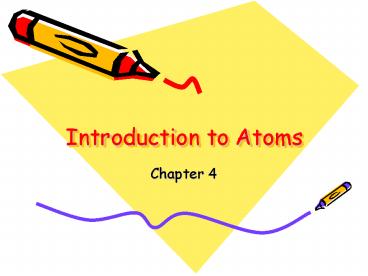Introduction to Atoms PowerPoint PPT Presentation
1 / 54
Title: Introduction to Atoms
1
Introduction to Atoms
- Chapter 4
2
Development of the Atomic Theory
- Section 1
- Page 80
3
Atom
- The smallest particle in which a element can be
divided and still be the same substance
Oxygen
4
(No Transcript)
5
Theory
- A unifying example for a broad range of hypothesis
6
Democritus Proposes the Atom
- uncutable particle
- Called it Atom meaning indivisible
7
Atoms
Stone Fur
8
(No Transcript)
9
Democritus Atom
- Small hard particles
- Made of a single material (different shape
size) - Always Moving
- From different material by joining together
10
Aristotle Disagrees
- Greek Philosophical
- You would never end up with a indivisible particle
11
Dalton
- Knew elements combine in specific proportions
- But Why?
12
Dalton
- Completed many experiments and concluded
- specific proportions are do to atoms
13
Daltons Theory
- All substances are made of Atoms
- Atoms can not be divide, created or destroyed
- Atoms of the same element are alike
- Atoms join with other atoms to make new substancs
14
Dalton Close but not Prefect
- New research produced new question concerning
Dalton theory
15
Thomason electron
16
http//www.chem.uiuc.edu/clcwebsite/cathode.html
17
Negative Corpuscles
- Corpuscles are negatively charge and now called
electrons
18
Plum Pudding
19
Ernest Rutherford
- Designed a experiment to test Thomsons theory on
the structure of an atom
20
http//www.mhhe.com/physsci/chemistry/essentialche
mistry/flash/ruther14.swf
21
Ernest Rutherford
- Positive charged Nucleus
- Nucleus is majority of the atoms mass
- Electrons orbit the nucleus
22
Bohrs Model
- Believed electrons orbited the nucleus in
specific paths - Paths were located on levels and electrons could
skip levels
23
(No Transcript)
24
Nuclear Fission
- An atom's nucleus can be split apart. When this
is done, a tremendous amount of energy is
released. - Nuclear power
- Atomic bomb
25
Nuclear Fusion
- Fusion means joining smaller nuclei (the plural
of nucleus) to make a larger nucleus. - Example Sun uses nuclear fusion of hydrogen
atoms into helium atoms. - This gives off heat and light and other
radiation.
26
Fusion by Magnetic Confinement
27
Modern Theory
- Electrons do not move in Paths
- The exact path can not be predicted
- Electron Clouds- regions where electrons are
found
28
(No Transcript)
29
What's inside an Atom
- Protons
- Neutrons
- Electrons
30
Atomic Mass units
- The SI unit used to express the mass of protons,
neutron and electrons
31
Nucleus
- Protons
- Positively Charged
- All protons are identical
- 1 amu
- Neutrons
- No Charge
- 1 amu
32
(No Transcript)
33
Electrons
- Found around the outside of the nucleus in
electron clouds - Have a negative charge
- 0 amu
34
(No Transcript)
35
Atom Charge
- The amount of neg. and positive charges on an
atom are equal - Atoms have no charge
- Example -1 1 0
36
Ions
- Atoms with Charge
- If more protons, positive
- If more electrons, negative
37
Isotopes
- Atoms of the same element with different numbers
of neutrons - For example, the most common isotope of hydrogen
has no neutrons at all - deuterium, with one neutron
- tritium, with two neutrons
Tritium
Hydrogen
Deuterium
38
Properties o Isotopes
- Limited Isotopes per element
- Have Unique Properties (unstable)
39
(No Transcript)
40
Unstable
- Meaning the atom nucleus can change it
composition (radioactive) - Most Chemical Physical Properties remain the
same
41
Differing Isotopes
- Mass number protons neutrons
- Remember electrons are not included because there
amu 0
42
Whats the mass number?
43
12
44
Whats the mass number?
45
39
46
- http//www.youtube.com/watch?vvDAZsPkTkMM
47
Calculating Atomic Mass
- Atomic Mass (mass of each Isotope) X
(Percentage abundance)
48
Steps to Calculating Atomic Mass
- Given
- Copper-63 at 69
- Copper-65 at 31
- First change percent to decimal form
- 69 .69
- 31 .31
49
Percent X Mass Number
- (63 X .69) 43.47 amu
- (65 X .31) 20.15 amu
50
Add the Mass
- 43.47 20.5 63.62 amu
51
Calculating parts of atoms
- Protons Atomic number
- Electrons protons
52
(No Transcript)
53
(No Transcript)
54
Homework
- Page 89 questions 1-3

